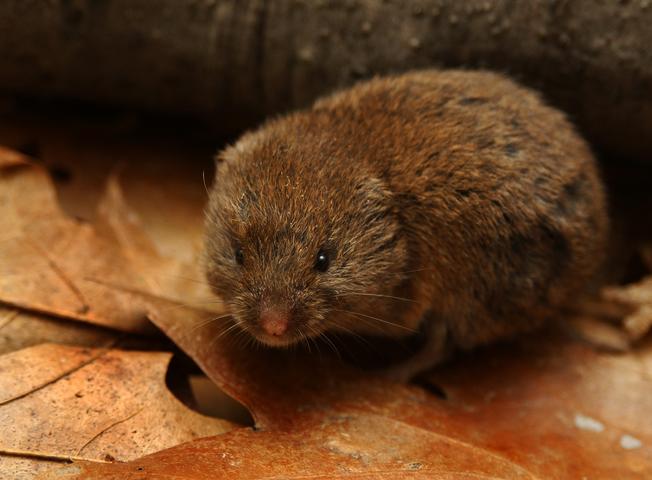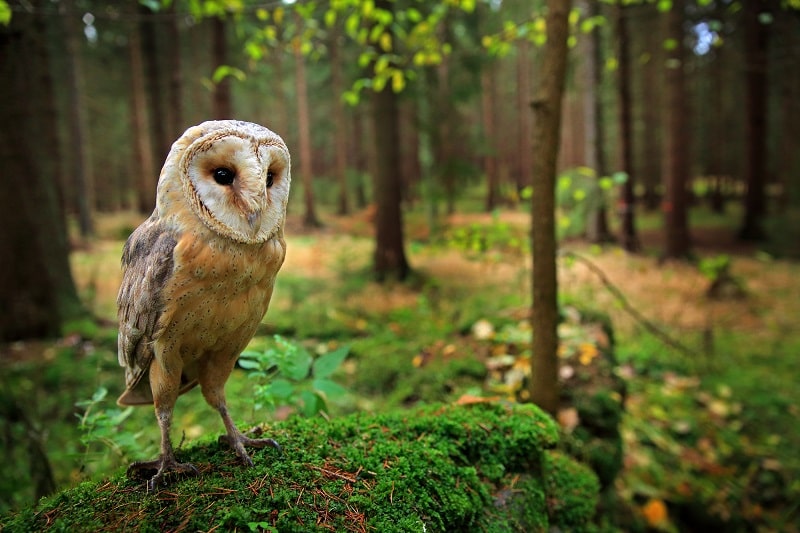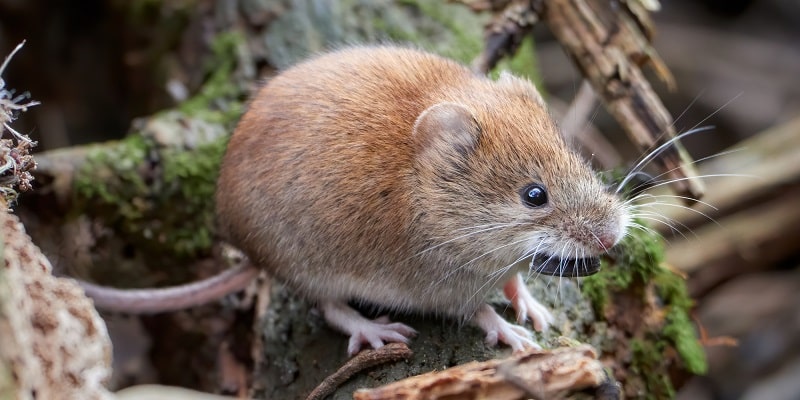[ad_1]
Have you had enough of voles treating your garden as an all-you-can-eat buffet? I have.
Voles might be cute and furry, but they seem intent on destroying our garden. They’ve been feasting on every bulb, root, or tuber we put in the ground. We haven’t seen a whole beet or sweet potato for months!
I don’t mind sharing the fruits of our labor with others, but I do mind when they steal everything, leaving nothing for us humans to enjoy.
The Destructive Power of the Vole


Several different species of voles cause mayhem and destruction, damaging lawns, orchards, trees, and even buildings. The most widespread of these is the meadow vole which is usually responsible for the maze-like grid of tunnels running through your garden.
Prairie voles are more commonly found on golf courses, while the woodland vole focuses its efforts on orchards and residential properties with lots of leaf litter.
One of the biggest problems with voles is how quickly they breed. A female vole becomes sexually mature at just 35 to 40 days old and produces 5 to 10 litters per year thereafter. With litter sizes ranging from 3 to 6, your vole population could explode in just a few months!
Not only do voles eat roots and tubers, but they also gnaw the stems of young trees and other woody plants and burrow through the ground, leaving a wasteland of dead plants in their wake.
Seven Ways To Stop Voles Wrecking Your Garden
Before we introduce you to the three most common ways of getting rid of voles, we need to deal with some of the legal implications of vole eradication. Always check the laws in your own state.
In some states, like Noth Carolina, it’s illegal to trap or kill nuisance animals unless you have a permit. If the law prevents you from using traps, you might want to try repellents and habitat modification to deter the little critters instead.
#1 Habitat Modification can Deter Voles
Meadow voles forage above ground, so they prefer areas of dense vegetation. The thick ground cover protects them against potential predators, whereas bare earth exposes them for all to see.
Removing weeds, vegetation, and heavy mulch from your garden help to eliminate their food source and remove any protection they might get from that ground cover.
Keeping your lawns closely mowed and removing grass and weeds from the bases of young trees can help prevent vole damage and encourage them to seek out new food sources.
It may sound a little drastic, but removing bird feeders from your garden can also help reduce your vole population. Bird feeders inevitably spill some seeds on the ground, attracting the neighborhood’s voles to the area. Removing them will give the voles less reason to invade your property.
You can also clear sections of land as “voles are less likely to traverse weed-free zones that are 15 feet wide.”
Remove the vole’s food sources and security, and you’ll be sure to notice a decline in their population. Habitat modification is rarely enough to eradicate a population of voles but works effectively with other methods, such as exclusion.
#2 Exclude Voles with Hardware Cloth Fencing
Fencing out something that weighs only a couple of ounces and measures just four to eight inches in length is no easy challenge. To do it effectively, you need a woven-wire or hardware cloth fencing that has ¼-inch mesh or smaller.
A vole-proof fence should start approximately 12 inches high and be buried 2 to 3 inches below the ground. Make it a bit taller, and you could keep rabbits and ground squirrels at bay as well.
You can also use hardware cloth to create cylinders around young trees that will prevent voles from gnawing on their bark.
#3 Natural Predators Help to Keep Voles at Bay

Encouraging natural predators into your garden will help keep your vole population under control.
Non-venomous snakes, raptors, domestic cats, raccoons, bobcats, and weasels all prey on voles, but you don’t necessarily want them roaming around your garden.
Voles are active throughout the day and night, using the cover of dark more in summer than winter. It’s hardly surprising then that voles are a favorite prey of barn owls. Not only that, but the owls appear to target pregnant female voles, making them even more efficient at suppressing the population.
#4 Decoys Can Frighten Voles into Submission
Not everyone wants real snakes in their gardens for obvious reasons. A rubber snake, on the other hand, is completely harmless but might just look intimidating enough to deter the voles that seem so intent on destroying your garden.
Decoy owls are also an option, although, like shrews, voles can be pretty shrewd! Voles observe their surroundings carefully and may figure out that a rubber snake or plastic owl poses little threat.
#5 Homemade Repellents can Reduce your Vole Population
You’d don’t need an actual predator, or even a decoy, to keep voles away. All you need is the urine of a predator. Predator pee is widely available and safe to use, unlike some of the other repellents we’ll be discussing. You still need to take care and use gloves when handling it as it may not be sterile.
Predator pee will help reduce your vole population to some degree, but it needs frequent reapplication if it’s to have the desired effect.
Other repellents are more potent, but also potentially harmful to others. Repellents registered for vole control usually contain either the fungicide thiram, or capsaicin, which is found in chili peppers.
Unfortunately, these commercial repellents are often expensive and only offer short-term protection. In the long run, voles become accustomed to the smell and start to ignore it, especially in winter when food is in short supply.
A cheaper approach is to make your own vole repellent, which you can do safely and easily.
When we looked at homemade mole poison and other tips for eliminating moles, we discovered castor oil as an effective repellent. It may not affect voles as severely as it does moles, but it produces a smell and taste that voles find abhorrent.
To use castor oil as a vole deterrent, mix one-part castor oil with one-part liquid soap and then dilute it in a gallon of water. Spray this solution around all the areas where you’ve seen evidence of vole activity.
Voles are also said to dislike the smell of coffee grounds, eggs, and hot peppers, so you could use any one of those to create your own homemade vole repellent.
Regardless of what you use as a repellent, you’ll need to reapply it regularly. Rain or heavy dew will dilute the repellent, making it less effective.
Ideally, you should use repellents before the vole damage gets out of control. Once the voles have established a feeding pattern, there’re much harder to deter.
Using repellents alongside habitat modification and exclusion controls is more successful in preventing than eradicating voles.
Therefore, you may need a two-pronged approach to your vole problem, starting with an eradication technique like trapping, then following up with some preventative strategies.
#6 Trapping Voles is Effective in Small Areas
Snap traps are one of the most effective ways of eradicating voles from a small area. It’s not possible to trap a large garden, but if the population is concentrated in a small area, like the size of the average backyard, trapping can be effective.
You’ll probably need around a dozen snap traps, each of which should be strategically placed on the vole’s runways or at the entrance to its burrow.
Bait each trap with peanut butter, oatmeal, and apple slices, although the vole often triggers the trap by running over it rather than targeting the bait.
To make the trap more enticing, place a box or bucket over it, so the vole is fooled into thinking it has some protection while eating. This approach will also prevent children and pets from accidentally triggering the traps.
You need to check and reset your traps daily. You’ll also need to dispose of any dead voles caught in the traps. Wear rubber gloves when handling the dead voles to reduce the risk of disease exposure, and either bury them or dispose of them in the garbage in plastic bags.
You don’t have to kill your voles to eradicate them. Humane traps allow you to trap the vole and relocate it to another place.
There are several advantages to using live traps. For one, you don’t have to deal with any dead bodies. Secondly, you can release any non-target species that are accidentally caught in the traps.
If you decide to go with live traps, relocate the voles at least 5 miles from your property. Any closer and they could be back before you are!
Bear in mind that some states have specific regulations regarding the use of live traps. In South Carolina, for instance, it’s illegal to relocate trapped animals “due to animal and human disease exposure.” Instead, all captured animals must be euthanized.
#7 Can You Make Homemade Vole Poison?
Commercial vole poisons, known as rodenticides, “work as coagulants.” When the vole eats the poison, it causes fatal internal bleeding. Most commercial rodenticides contain either chlorophacinone, diphacinone, or warfarin.
The safest vole poisons are safe to use around pests and biodegradable, so they’ll simply decompose if not consumed.
For any poison to be effective, you need the vole to eat it, and that means fooling it into thinking the bait is something irresistibly delicious. This is the tricky bit.
Voles are intelligent little critters that are difficult to trick. As a result, some people recommend using different poisoned feeds rotated with repellents and traps to get the upper hand.
Despite searching high and low, I couldn’t find any recipes for homemade vole poison. I never found any for moles either, which suggests that some burrowing animals are just too difficult to fool.
Conclusion
There’s nothing cute about a vole that keeps stealing your veggies, burrowing through your law, or gnawing on your trees.
Preventive measures are usually effective at keeping voles away, but if you already have a large population wreaking havoc in your garden, you may need to consider a combination of traps and fences to get on top of the problem.
[ad_2]
Source link
